However, Anterior Cruciate Ligament (ACL) injuries have drastically increased during this time period.
This paper will discuss the development of ski equipmentbindings in particularwith the goal of reducing ACL injuries.
These injuries typically occur because of the app of a critical load to the knee during a fall.
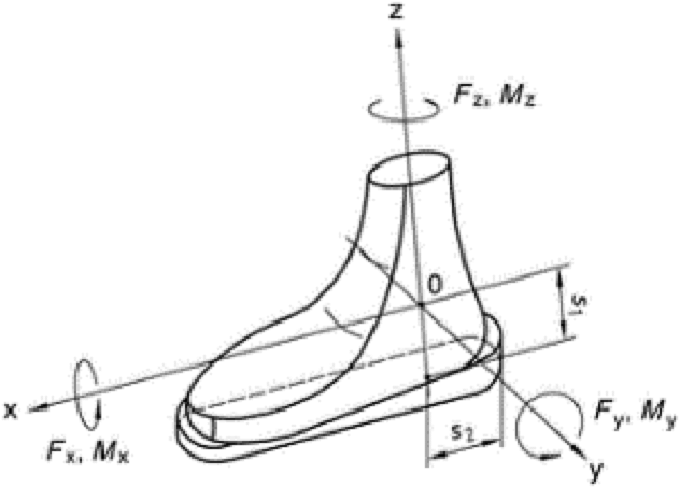
STRIVING FOR A SAFER SKI BINDING
One could argue that sports are the most popular hobby in American culture.
Viewers revere the athletic talent on display every day of the week.
On a smaller scale, sports have a number of benefits for individuals.

However, many sporting activities also come with the inherent risk of injury.
Football players risk brain damage.
Tennis players risk the painful ligament damage known as tennis elbow.

Skiers in particular risk ACL injuries among many others.
Injuries like this can be career-ending for athletes like Vonn.
Without any kind of release, a skier’s leg would be forced into the boot.
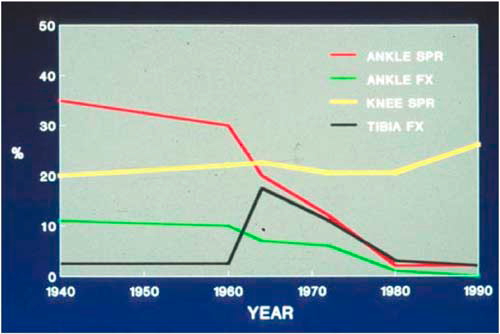
With large enough force, or sustained force, the skier’s tibia would fracture under the pressure.
There was a call for bindings that could prevent these injuries.
The skier’s boot can then be attached to the ski through use of the binding.
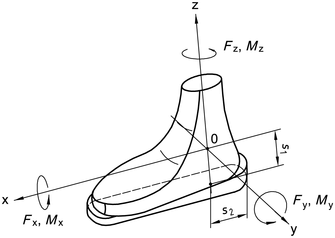
The release mechanism works using a spring system in both the toepiece and heelpiece.
A higher tension setting results in more force necessary to release the binding.
FIGURE 1 [8].
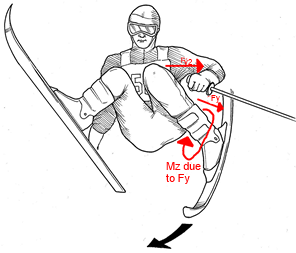
For aggressive, advanced-level skiers, this could be the cause of severe injury.
FIGURE 2 [9].
Nearly every aspect of binding and boot designs are addressed by DIN.
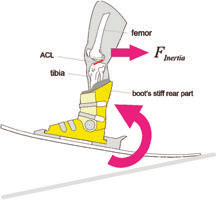
The higher the DIN value, the tighter the binding spring tension.
This is mainly due to the technical purpose of ski bindings.
FIGURE 3 [11].
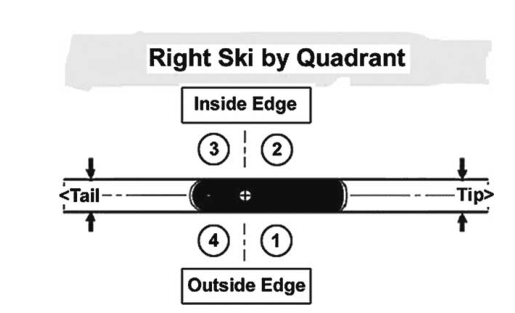
This shows that current bindings are not truly designed to account for knee injuries.
Therefore, the bindings must be modified if they are to account for ACL injuries.
This understanding is critical if to correctly modify equipment to prevent specific loads on the knee’s ligaments.
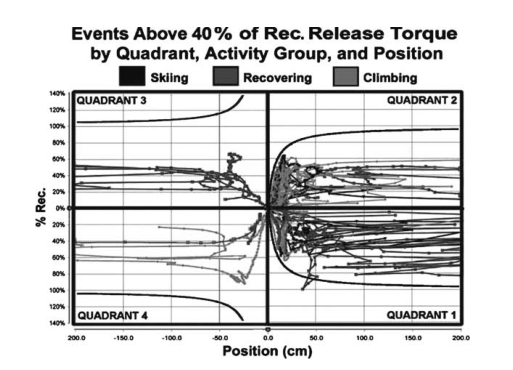
These are set in Figure 4.
FIGURE 4 [1].
As the skier falls, his body twists in the downhill direction.
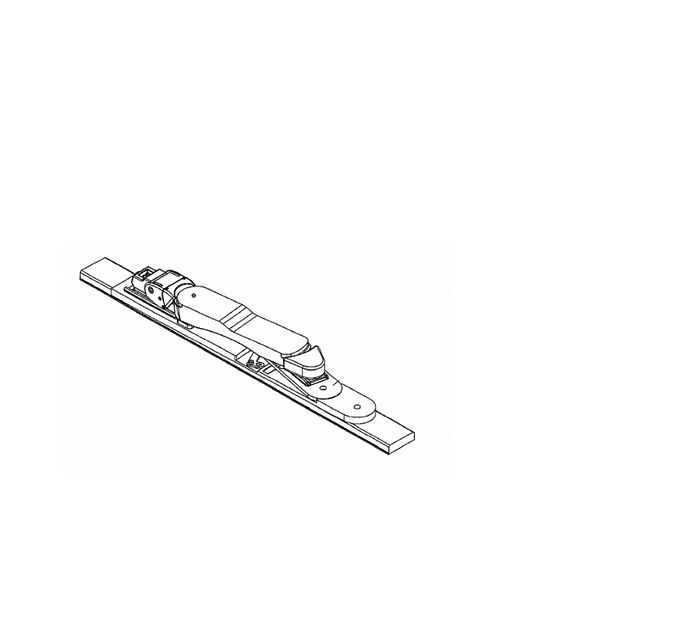
This results in internal rotation of the tibia and valgus, blowing out the ACL [13].
Therefore, the binding does not register the force or release because there is no lever arm.
FIGURE 5 [12].

Skier in a typical phantom foot situation.
Along with knee flexion of greater than 90 degrees, these factors result in a torn ACL.
A boot induced anterior drawer situation usually occurs while a skier lands off balance to the back while jumping.
The ski, in combination with the stiff boot, causes a moment about the y-axis.
The force pushes the tibia forward in relation to the femur, which tears the ACL [13].
Figure 6 is a visual representation of this mechanism.
FIGURE 6 [1].
By doing so, skiing can become an even safer sport.
By reducing injuries significantly, engineers can have a profound impact on skiing.
Before a discussion about “safer” bindings, it is important to discuss what exactly makes bindings safe.
There is a good reason for the stagnation of binding design in the last 20 years.
The central aspect of this issue is premature release.
Current binding standards, as already discussed, are designed to maximize the protection against tibia fractures.
However, they also have a second, equally important function: minimize premature release.
Any suggested binding design must take into account this important factor.
If a binding releases in situations when it is not intended to, it must immediately be reevaluated.
Premature release poses the most challenging problem for any engineer attempting to create a new binding.
The Mechanical Solution
All bindings currently on the market can be classified as mechanical bindings.
These release when a sufficiently large force acts on a proper area of the ski-boot-binding interface.
Therefore, a mechanical solution to this problem is the incorporation of additional degrees of freedom.
This new triggering axis can sense the force that previously would have gone undetected [1].
FIGURE 7 [15].
Quadrants as defines by Ettlinger and his team.
This finding is displayed graphically in Figure 8 [15].
FIGURE 8 [15].
The binding utilizes a pivoting system of platforms atop the ski.
These springs can be tightened or loosened to decrease or increase the likelihood of release.
This force could pivot the “trigger platform” under the binding counterclockwise relative to the ski.
Figure 9 shows the pivoting release described above.
FIGURE 9 [16].
In theory, this solution would directly counteract the anterior drawer mechanism.
Many companies have tried to implement this technology, but currently, the market is almost devoid of them.
The major drawback is premature release.
Ettlinger’s design would also be reasonably priced.
and can be acquired inexpensively [16].
The Mechatronic Solution
The other major category of “safer” ski binding designs is mechatronic bindings.
Instead, it acts as a force measurement gear.
The heelpiece is where all the mechanisms for releasing the boot are contained.
The system allows for elasticity in three directions.
The rotational elasticity helps to prevent inadvertent pre-release of the boot from the binding.
FIGURE 10 [18].
Diagrams showing the mechanism of the heelpiece in Neptune and Hull’s prototype binding.
The bottom diagram shows the highlighted lever portion, blown up for ease of viewing.
However, as of today there is one major flaw with the incorporation of mechatronics into ski bindings.
Therefore, mechatronic bindings are currently unsustainable since they are too expensive for anyone to buy.
This cost opposes the sustainable improvement in quality of life and safety that comes with such an advanced binding.
A SUSTAINABLE MENTALITY
As an idea, sustainability is multifaceted.
One could say that sustainability means cost effectiveness, eco-friendliness, or easy to manufacture.
However, it can also include the idea of improved quality of life.
In this case, quality of life can be defined as peace of mind, safety, and health.
By implementing bindings that reduce ACL injuries, the overall quality of life of skiers will improve.
Safer bindings will give skiers greater peace of mind, and decrease injuries in the population.
ACL injuries are extremely expensive affairs.
The average cost of an ACL injury is about $35,000 [19].
However, that is just the average.
Still, the huge costs exist as a strain on the economy.
Somewhere along the line, someone will have to pay for the injury.
For hospitals, much of the cost associated with patients with ACL injuries is efficiency.
Many obstacles prevent the widespread adoption of ACL-friendly bindings in the market.
Perhaps the central aspect of the problem is the skiing industry’s traditional standards.
The research that led to this paper has revealed a glaring deficiency on the market of innovative bindings.
The skiing safety community has been aware of ACL injury mechanics like the phantom foot for over 20 years.
However, over that time, bindings have undergone very little evolution.
Years of research have been devoted to ACL injuries in skiing.
Manufacturers and engineers have all the necessary information and technology needed to develop better bindings.
After a set of concrete standards are defined, the industry will more readily implement the technology.
REFERENCES
[1] V. Senner, F. I. Michel.
“Ski Equipment-Related Measures to Reduce Knee Injuries.”
International Sports Engineering Association.
(Online article).http://www.sportsengineering.org/wp-content/uploads/2013/12/ISSS-broschure_bfu-TUM.pdf.
[2] “The Health Benefits of Sport and Physical Activity.”
(Online Article).http://www.sportanddev.org/en/learnmore/sport_and_health/the_health_benefits_of_sport_and_physical_activity/
[3] R. Johnson, C. Ettlinger, J. Shealy.
“Update on Injury Trends in Alpine Skiing.”
Journal of ASTM International.
(Online article).http://www.astm.org/digital_library/journals/jai/pages/jai102046.htm.
[4] C. F. Finch, H. L. Kelsall.
“The Effectiveness of Ski Bindings and Their Professional Adjustment for Preventing Alpine Skiing Injuries.”
(Online article).http://www.ncbi.nlm.nih.gov/pubmed/9680660.
[5] “Anterior Cruciate Ligament Injuries (Isolated).”
University of Minnesota Orthepedics.
(Website).http://www.sportsdoc.umn.edu/Patients_Folder/Knee/aclreconpat/aclreconpat2.htm.
[6] B. Pennington.
“Lindsey Vonn’s Injured Knee Will Keep Her Out of Sochi Games.”
The New York Times.
(Online article).http://www.nytimes.com/2014/01/08/sports/olympics/lindsey-vonn-wont-ski-at-the-sochi-games.html.
[7] S. Masia.
History of Ski Safety Bindings."
International Skiing History Association.
(Online Blog Post).http://skiinghistory.org/history/release-history-safety-bindings.
[8] “Ski Bindings.”
(Online article).http://www.mechanicsofsport.com/skiing/equipment
/bindings.html.
[9] “Rossignol Axial2 120 Ski Binding.”
(Website).http://www.evo.com/shop/ski/bindings.aspx.
[10] “DIN Setting Calculator.”
(Website).http://www.dinsetting.com/index.htm.
[11] C. F. Ettlinger, R. J. Johnson, J. Shealy.
“Functional and Release Characteristics of Alpine Ski Equipment.”
Journal of ASTM International.
(Online article).http://enterprise.astm.org/subscription/digital_library/stp/pages/stp39659s.htm.
[12] C. F. Ettlinger, R. J. Johnson, J. Shealy.
“A Method to Help Reduce the Risk of Serious Knee Sprains Incurred in Alpine Skiing.”
The American Journal of Sports Medicine.
(Online Article).http://www.ncbi.nlm.nih.gov/pubmed/8526266
[13] S. Freudiger, N. E. Friederich.
“Critical Load Cases for Knee Ligaments at SkiingAn Engineering Approach.”
Skiing Trauma and Safety: Thirteenth Volume.
(Online article).http://enterprise.astm.org/subscription/digital_library/stp/pages/stp12874s.htm.
[14] “Technical and Background Information.”
(Online write-up).http://www.kneebinding.com/KB-InformationCenter3.aspx.
“Retention Requirements for Alpine Ski Bindings.”
(Online article).http://enterprise.astm.org/subscription/digital_library/journals/jai/pages/jai102978.htm.
[16] C. F. Ettlinger, D. J.
- “Alpine Ski Binding Having Release Logic For Inhibiting Anterior Cruciate Ligament Injury.”
US 7,762,572 B2.
[17] M. L. Hull.
“A Survey of Actively Controlled (Electronic) Snow Ski Bindings.”
Skiing Trauma and Safety: Fifth International Symposium.
(Online article).
[18] R. R. Neptune, M. L. Hull.
“Electromechanical Ski Binding with Release Sensitivity to Torsion and Bending Moments Transmitted by the Leg.”
Skiing Trauma and Safety: Tenth Volume.
(Online article).http://enterprise.astm.org/subscription/digital_library/stp/pages/stp37942s.htm.
[19] T. L. Chancellor.
What is the average cost of ACL Surgery?
(Online article).http://www.ehow.com/about_5398546_average-cost-acl-surgery.html
[20] C. French-Owen.
The Cost of an ACL Injury.
The Journal of Bone and Joint Surgery.
(Online article).http://jbjs.org/data/Journals/JBJS/927628/1751.pdf
ADDITIONAL SOURCES
“ACL Injuries From Alpine Skiing.”
California Pacific Orthopaedics and Sports Medicine.
(Online article).http://www.cposm.com/sports-medicine/skiing-injuries/acl-injuries.
R. Bahr, T. Krosshaug.
“Understanding Injury Mechanisms: A Key Component of Preventing Injuries in Sport.”
British Journal of Sports Medicine.
(Online article).http://www.ncbi.nlm.nih.gov/pubmed/15911600.
B. Caldwell, D. Landry, M. L. Hull.
“A Mechanical Ski Binding with Heel Release Activated by the Bending Moment at the Boot Sole.”
Skiing Trauma and Safety: Ninth International Symposium.
(Online article).http://enterprise.astm.org/subscription/digital_library/stp/pages/stp25570s.htm.
S. Freudiger, W. Vogt, D. Wirz.
“Relative Motion of ACL Insertion Points In Vivo: A Case Study, Including Skiing Maneuvers.”
Journal of ASTM International.
(Online article).http://www.astm.org/digital_library/journals/jai/pages /jai102831.htm.
R. Johnson, C. Ettlinger, J. Shealy.
Skiing Trauma and Safety: Fourteenth Volume.
(Online article).http://enterprise.astm.org/subscription/digital_library/stp/pages/stp10960s.htm.
U. Lindsjo, H. Ekstrom, J. Gustavsson.
“Release and Retention in Apline Ski Bindings.”
International Journal of Sports Medicine.
(Online article).http://www.ncbi.nlm.nih.gov/pubmed/6874175.
V. Senner, F. I. Michel, S. Lehner, O. Bru gger.
“Technical Possibilities for Optimising the Ski-Binding-Boot Functional Unit to Reduce Knee Injuries in Recreational Alpine Skiing.”
International Sports Engineering Association.
(Online article).http://link.springer.com/article/10.1007%2Fs12283-013-0138-7#page-1.
J. E. Shealy, I. C. F. Ettlinger, R. J. Johnson.
“Using Signal Detection Theory as a Model to Evaluate Release/Retention Criteria in Alpine Skiing.”
Journal of ASTM International.
(Online article).http://www.astm.org.
G. S. Wunderly, M. L. Hull.
“A Biomechanical Approach to Alpine Ski Binding Design.”
International Journal of Sport Biomechanics.
(Online article).http://journals.humankinetics.com/jab-back-issues/jabvolume5issue3august/abiomechanicalapproachtoalpineskibindingdesign.